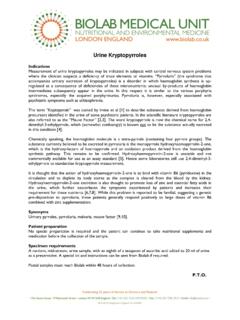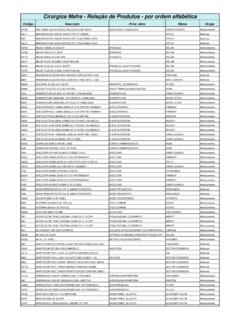Transcription of Hair Mineral Analysis 104 - biolab.co.uk
1 Hair Mineral Analysis September 2012 Hair element Analysis remains an important tool in the nutritional and environmental assessment of patients. In spite of various objections in the literature that the analyses may be poorly controlled, that different laboratories produce may different results from the same sample and also that the clinical interpretation of the results may be obscure [1], a measurement of the elemental concentration in recently-grown hair provides an integrated view of the element status in the follicular cells and their blood supply, unaffected by short term fluctuations in the nutrient intake of the subject.
2 Hair Analysis at Biolab has recently been re-standardised and, with the introduction of the state-of-the-art trace element Analysis , ICP-MS (Inductively Coupled Plasma Mass Spectrometry) technology, we now report hair Mineral Analysis results with an adjusted reference range relevant to this technology. Hair growth The structural proteins of hair are formed as a filament arising from the matrix of follicular cells in the epidermal epithelium. Human hair is approximately 80% protein and 15% water, with smaller amounts of lipid and inorganic substances [2].
3 Hair growing from the human scalp normally follows a definite growth cycle: anagen (the growth phase), catagen (a period of controlled regression of the hair follicle, when the cells become inactive and the hair fibre stops growing) and telogen (when the follicle is in a resting state and the hair may fall out) [3]. Normally more than 90% of human head hair is in the growth phase and it is at this stage that elements from the follicular cells and their blood supply are incorporated into the structure of hair.
4 These may be nutrient elements, such as zinc and magnesium, present in the follicular cells as enzyme co-factors, or toxic elements, poorly handled by renal excretion, which are dumped into the hair as part of a detoxification mechanism. Hence mercury, lead and arsenic show considerable enrichment in hair as compared to blood levels. Other elements, such as zinc and magnesium, show some enrichment over blood levels (reflecting their high intracellular concentrations), while others, such as iron, show no enrichment over blood levels (which for iron are, of course, much higher than serum levels).
5 So elements are normally incorporated into the filamentous structure of hair for plausible, predictable biological reasons. As the hair follicle emerges through the skin surface, the process of keratinisation (incorportation of cysteine residues) seals the formed elements within the protein structure, making the hair a resilient and long-lasting tissue [4] that can be used for a variety of analyses. The presence of sulphydryl groups from cysteine means that hair will selectively chelate and indefinetly retain heavy metals.
6 Limitations to the use of hair Analysis for assessment of minerals status While the cycle of hair production normally continues for the whole lifespan, other factors, such as adverse reactions to drugs and tumors, radiation damage and other toxic reactions, may lead to the physical destruction of the hair follicle. This will affect the overall rate of hair growth and the incorporation of elements into the hair shaft. Human hair normally grows at about cm per month, but, for example, prolonged zinc deficiency, or protein-energy malnutrition [5], slows down hair growth and may thus elevate the concentration of heavy metals in the hair (since the same mass of mercury, lead and cadmium is being incorporated into a smaller volume of hair tissue).
7 2 Many cosmetic treatments and colourants contain metals, especially magnesium and copper. If hair that has had such treatments in incorporated into the analytical sample, very high values will be recorded for these elements, which may mask deficiencies. Shampoos may contain sodium, potassium, zinc and selenium in substantial amounts and it is not always possible to wash these elements from the hair, either with normal rinsing in the bathroom or ex-vivo in the laboratory [6]. Procedure for hair element Analysis Hair samples are analysed by ICP-MS for a number of nutritional elements (calcium, chromium, cobalt, copper, iron, magnesium, manganese, phosphorus, potassium, selenium, sodium and zinc) and also for toxic elements (aluminium, arsenic, cadmium, lead, mercury and nickel).
8 Careful sample preparation is used to remove adhering particles and fluids which may also contain these elements. Since hair treatments, such as colourants and highlights, are Mineral -based, patients are advised to wait for twelve weeks before submitting hair clippings for Analysis if one of these treatments has been used. To provide an index of normality, each set of hair element results is compared with reference intervals which have been derived from Biolab s extensive database.
9 We have recently improved our sample preparation technique (the hairs are now dissolved by microwave in a closed container) and this has resulted in better recovery of lead and mercury, in particular. It is intended to introduce several more elements into the profile in due course, at which time the reference intervals will be reviewed again. Quality control of the analyses is carried out by repeat re- Analysis of pooled hair extracts, as well as by Analysis of serum and blood samples with known elemental concentrations.
10 There is no external quality assessment scheme for hair, but we have validated our results and reference ranges by comparison with certified reference hair samples from the National Institute for Environment Studies, Japan [7] and from the Community Bureau of Reference of the Commission of the European Communities [8]. The analytical methods (as opposed to the sample preparation techniques) used for hair Analysis are the same as those used for plasma, blood and urine elements, which are subject to external quality assessment in recognized schemes.






